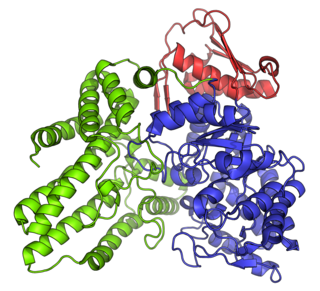Related Research Articles

The enzyme α-N-acetylglucosaminidase is a protein associated with Sanfilippo syndrome, with systematic name α-N-acetyl-D-glucosaminide N-acetylglucosaminohydrolase. It catalyses the hydrolysis of terminal non-reducing N-acetyl-D-glucosamine residues in N-acetyl-α-D-glucosaminides, and also UDP-N-acetylglucosamine.
Exoribonuclease II is an enzyme. This enzyme catalyses the following chemical reaction

Ribonuclease 4 is an enzyme that in humans is encoded by the RNASE4 gene.

Morpheeins are proteins that can form two or more different homo-oligomers, but must come apart and change shape to convert between forms. The alternate shape may reassemble to a different oligomer. The shape of the subunit dictates which oligomer is formed. Each oligomer has a finite number of subunits (stoichiometry). Morpheeins can interconvert between forms under physiological conditions and can exist as an equilibrium of different oligomers. These oligomers are physiologically relevant and are not misfolded protein; this distinguishes morpheeins from prions and amyloid. The different oligomers have distinct functionality. Interconversion of morpheein forms can be a structural basis for allosteric regulation, an idea noted many years ago, and later revived. A mutation that shifts the normal equilibrium of morpheein forms can serve as the basis for a conformational disease. Features of morpheeins can be exploited for drug discovery. The dice image represents a morpheein equilibrium containing two different monomeric shapes that dictate assembly to a tetramer or a pentamer. The one protein that is established to function as a morpheein is porphobilinogen synthase, though there are suggestions throughout the literature that other proteins may function as morpheeins.
9,9'-dicis-zeta-carotene desaturase is an enzyme with systematic name 9,9'-dicis-zeta-corotene:quinone oxidoreductase. This enzyme catalyses the following chemical reaction
(Methyl-Co methanol-specific corrinoid protein):coenzyme M methyltransferase is an enzyme with systematic name methylated methanol-specific corrinoid protein:coenzyme M methyltransferase. This enzyme catalyses the following chemical reaction
Ribonuclease T2 is an enzyme. It is a type of endoribonuclease. This enzyme catalyses the following chemical reaction
Ribonuclease is an enzyme. This enzyme catalyses the following chemical reaction
Ribonuclease IX is an enzyme. This enzyme catalyses the following chemical reaction
Ribonuclease F is an enzyme. This enzyme catalyses the following chemical reaction
Aminopeptidase S is an enzyme. This enzyme catalyses the following chemical reaction
Pyroglutamyl-peptidase II is an enzyme. This enzyme catalyses the following chemical reaction
Gamma-D-glutamyl-meso-diaminopimelate peptidase is an enzyme. This enzyme catalyses the following chemical reaction
Hypodermin C is an enzyme. This enzyme catalyses the following chemical reaction
Endothiapepsin is an enzyme. This enzyme catalyses the following chemical reaction
Phytepsin is an enzyme. This enzyme catalyses the following chemical reaction
Biotin-independent malonate decarboxylase (EC 4.1.1.88, malonate decarboxylase (without biotin), malonate decarboxylase, MDC) is an enzyme with systematic name malonate carboxy-lyase (biotin-independent). This enzyme catalyses the following chemical reaction
Biotin-dependent malonate decarboxylase (EC 4.1.1.89, malonate decarboxylase (with biotin), malonate decarboxylase) is an enzyme with systematic name malonate carboxy-lyase (biotin-dependent). This enzyme catalyses the following chemical reaction
Low-specificity L-threonine aldolase is an enzyme with systematic name L-threonine/L-allo-threonine acetaldehyde-lyase (glycine-forming). This enzyme catalyses the following chemical reaction
Acetate—[acyl-carrier protein] ligase is an enzyme with systematic name acetate:(acyl-carrier-protein) ligase (AMP-forming). This enzyme catalyses the following chemical reaction
References
- ↑ Müller WE (November 1976). "Endoribonuclease IV. A poly(A)-specific ribonuclease from chick oviduct. 1. Purification of the enzyme". European Journal of Biochemistry. 70 (1): 241–8. doi:10.1111/j.1432-1033.1976.tb10975.x. PMID 1009928.
- ↑ Müller WE, Seibert G, Steffen R, Zahn RK (November 1976). "Endoribonuclease IV. 2. Further investigation on the specificity". European Journal of Biochemistry. 70 (1): 249–58. doi:10.1111/j.1432-1033.1976.tb10976.x. PMID 1009929.